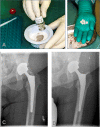Enough is enough: salvage procedures in severe periprosthetic joint infection
- PMID: 37394449
- PMCID: PMC10316561
- DOI: 10.1186/s42836-023-00182-7
Enough is enough: salvage procedures in severe periprosthetic joint infection
Abstract
Background: In severe cases of periprosthetic joint infection involving negative host-dependent factors, individual-based decisions between a curative therapy vs. salvage procedure are necessary. We aimed to review salvage procedures in severe periprosthetic joint infection cases, where a gold standard of a curative two-stage exchange can no longer be achieved. The options of knee arthrodesis, amputation, persistent fistula (stable drainage), or a debridement, antibiotics, and implant retention procedure in late-onset cases are discussed, including lifelong antibiotic suppression alone.
Methods: We focused on known salvage procedures for severe periprosthetic joint infection of the hip and knee, such as amputation, arthrodesis, antibiotic suppression, persistent fistula, and debridement, antibiotics, and implant retention in late-stage infections, and the role of local antibiotics. The current literature regarding indications and outcomes was reviewed.
Results: Whereas a successful single-stage above-knee amputation can be a curative effort in younger patients, this is associated with limited outcome in older patients, as the proportion who receive an exoprosthesis leading to independent mobility is low. Therefore, arthrodesis using an intramedullary modular nail is an option for limb salvage, pain reduction, and preservation of quality of life and everyday life mobility, when revision total knee arthroplasty is not an option. Carrying out a persistent fistula using a stable drainage system, as well as a lifelong antibiotic suppression therapy, can be an option, in cases where no other surgery is possible. Active clinical surveillance should then be carried out. A debridement, antibiotics, and implant retention procedure in combination with local degradable antibiotics can be used and is an encouraging new option, but should not been carried out twice.
Conclusion: Whereas the gold standard in periprosthetic joint infection treatment of late infections remains the exchange of the prosthesis, salvage procedures should be considered in the cases of reduced life expectancy, several recurrences of the infection, patients having preference and negative host factors. In these cases, the appropriate salvage procedure can temporarily lead to remission of the infection and the possibility to maintain mobility.
Keywords: Amputation; Antibiotic suppression; Arthrodesis; Debridement, antibiotics, implant retention; Periprosthetic joint infection; Salvage procedure.
© 2023. The Author(s).
Conflict of interest statement
The authors declare that they have no competing interests.
Figures




Similar articles
-
Modular knee arthrodesis secures limb, mobility, improves quality of life, and leads to high infection control in periprosthetic knee infection, when revision knee arthroplasty is not an option.Arch Orthop Trauma Surg. 2021 Aug;141(8):1349-1360. doi: 10.1007/s00402-021-03907-y. Epub 2021 Apr 23. Arch Orthop Trauma Surg. 2021. PMID: 33893531
-
Knee arthrodesis with a long intramedullary nail as limb salvage for complex periprosthetic infections.Eur J Orthop Surg Traumatol. 2016 Dec;26(8):907-914. doi: 10.1007/s00590-016-1827-2. Epub 2016 Jul 29. Eur J Orthop Surg Traumatol. 2016. PMID: 27473317
-
Periprosthetic joint infection: treatment options.Orthopedics. 2010 Sep 7;33(9):659. doi: 10.3928/01477447-20100722-42. Orthopedics. 2010. PMID: 20839679
-
Debridement, antibiotics, and implant retention after revision arthroplasty : antibiotic mismatch, timing, and repeated DAIR associated with poor outcome.Bone Joint J. 2022 Apr;104-B(4):464-471. doi: 10.1302/0301-620X.104B4.BJJ-2021-1264.R1. Bone Joint J. 2022. PMID: 35360944 Review.
-
Contemporary outcomes of debridement, antibiotics and implant retention in knee arthroplasty.Ann Jt. 2022 Jan 15;7:9. doi: 10.21037/aoj-20-76. eCollection 2022. Ann Jt. 2022. PMID: 38529130 Free PMC article. Review.
Cited by
-
Advances and Challenges in Orthopedic Implant-Associated Infections.Healthcare (Basel). 2024 Sep 11;12(18):1819. doi: 10.3390/healthcare12181819. Healthcare (Basel). 2024. PMID: 39337160 Free PMC article.
-
Debridement, Antibiotics, and Implant Retention (DAIR) in Acute Hematogenous Total Knee Arthroplasty Infections: A Case Series.Cureus. 2024 Sep 16;16(9):e69497. doi: 10.7759/cureus.69497. eCollection 2024 Sep. Cureus. 2024. PMID: 39416543 Free PMC article.
-
Knee Arthodesis , as a salvage procedure for Non-union of floating knee after ilizarov fixation-A case report.J Orthop Case Rep. 2025 Aug;15(8):239-243. doi: 10.13107/jocr.2025.v15.i08.5954. J Orthop Case Rep. 2025. PMID: 40786794 Free PMC article.
-
Titanium-Dioxide-Nanoparticle-Embedded Polyelectrolyte Multilayer as an Osteoconductive and Antimicrobial Surface Coating.Materials (Basel). 2023 Nov 3;16(21):7026. doi: 10.3390/ma16217026. Materials (Basel). 2023. PMID: 37959623 Free PMC article.
-
Single-stage revision in the management of prosthetic joint infections after total knee arthroplasty - A review of current concepts.J Clin Orthop Trauma. 2024 May 24;52:102431. doi: 10.1016/j.jcot.2024.102431. eCollection 2024 May. J Clin Orthop Trauma. 2024. PMID: 38854773 Free PMC article.
References
-
- Klug A, Gramlich Y, Rudert M, Drees P, Hoffmann R, Weißenberger M, et al. The projected volume of primary and revision total knee arthroplasty will place an immense burden on future health care systems over the next 30 years. Knee Surg Sports Traumatol Arthrosc. 2021;29(10):3287–3298. doi: 10.1007/s00167-020-06154-7. - DOI - PMC - PubMed
Publication types
LinkOut - more resources
Full Text Sources
